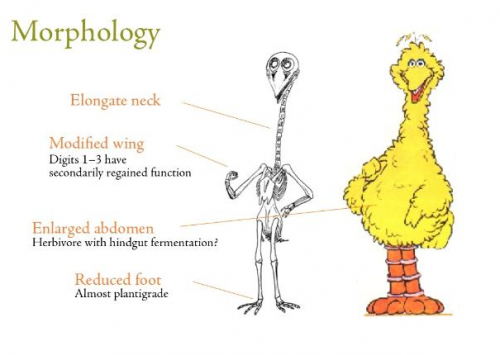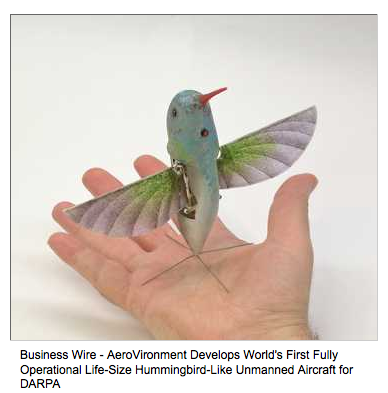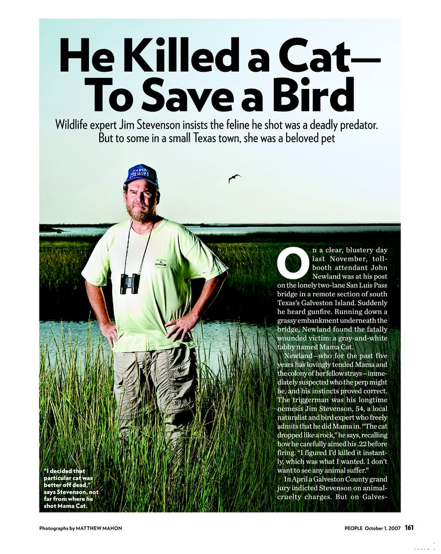 A PhD has actually tried to fit Big Bird from Sesame Street into current taxonomy. Time to reprint some field guides. Watch the whole thing, it is hilarious!
A PhD has actually tried to fit Big Bird from Sesame Street into current taxonomy. Time to reprint some field guides. Watch the whole thing, it is hilarious!
Birdchick Blog
 A PhD has actually tried to fit Big Bird from Sesame Street into current taxonomy. Time to reprint some field guides. Watch the whole thing, it is hilarious!
A PhD has actually tried to fit Big Bird from Sesame Street into current taxonomy. Time to reprint some field guides. Watch the whole thing, it is hilarious!
I'm not making that up.

And before anyone starts up with, "How could they waste taxpayer dollars like that," consider this: at least they didn't kill thousands of hummingbirds beforehand in an effort to figure out how to attach a camera and control them. You can read the full story here and below is video of RoboHummer in action...hm..I wonder if "RoboHummer" is already a patented item in the adult industry?
[youtube]http://www.youtube.com/watch?v=a8ZbtZqH6Io[/youtube]
THERE IS NOW AN UPDATE TO THIS BLOG ENTRY.
Someone asked me yesterday if it is safe to feed peanut butter suet considering the concern over recalled industrial strength peanut butter containing salmonella. This got me wondering if peanut butter suet is a risk for birds and should I stop feeding it? There's not a lot of regulation when it comes to wild bird feed and the Wild Bird Feeding Industry is such a slow moving organization, I doubt they would have answers. I went to three major suet company websites to see if I could get any info. I chose the three companies that I see distributed the most and these are also the three companies who make suet products that I use in my own feeders and like. Here is what I found:
C&S Suet guarantees that their peanut butter suet is 100% safe and free of salmonella.
Pine Tree Farms has no info and no such guarantee on their website. I'm going to try and call them to find out.
The Woodpecker Attractor plugs (and my personal favorite the No Melt Peanut Butter Suet Plugs) also has no info and no guarantees of safely from salmonella on their website. I'm also going to try and call them this week to find out the situation.
According to National Geographic, Mexico is cracking down on the parrot trade:
President Felipe Calderón Hinojosa has signed into law a bill to ban the capture and export of Mexican wild parrots. The bill, introduced one year ago by the Environment Commission of the Deputy Chamber, was passed in the Mexican Senate on 22 April, 2008 with near unanimous support (66 votes in favor, 0 votes against, and 1abstention).
Mexico considers half of its 22 parrot species endangered, and all but two are protected by federal law.
But between 65,000 and 78,000 parrots and guacamayas—a bigger type of parrot—are captured illegally every year, and most of these birds die each year before reaching their intended buyers.
The government has been unable to control the clandestine capture and sale of the protected birds, environmentalists say. The new ban—an amendment to Mexico's wildlife law—will eliminate the parrot and guacamaya market completely. The law will go into effect when it is published in the official congressional diary, possibly by the end of October (this month).
The Defenders of Wildlife Mexico report identified U.S. demand as a major driving force behind the illegal trade for some species, such as the yellow-naped parrot, which is found only in the Mexican state of Chiapas.
Mexico is home to 22 species of parrots and macaws, of which six are found nowhere else in the world. Approximately 90 percent of all parrots and macaws found in Mexico are in some category of risk. The latest Mexican classification (yet to be published) lists 11 species as endangered, five as threatened, four as requiring special protection, and two as unclassified.
Although this bill marks an immense victory for parrot conservation, much work is yet to be done.
I think that last sentence is an understatement!
How is this new ban to be enforced. Will the ban put a higher price on these birds making them even more valuable to poachers? Does Mexico have enough officers to enforce this new ban? Will this put further pressure on other bird species? Okay, so there's a ban on parrots, will more cardinals, tanagers, and buntings be seen in open markets for sale?
This is a cautious victory.
According to Science Daily:
Scientists at the Smithsonian Institution have discovered a new species of bird in Gabon, Africa, that was, until now, unknown to the scientific community.
The newly found olive-backed forest robin (Stiphrornis pyrrholaemus) was named by the scientists for its distinctive olive back and rump. Adult birds measure 4.5 inches in length and average 18 grams in weight. Males exhibit a fiery orange throat and breast, yellow belly, olive back and black feathers on the head. Females are similar, but less vibrant. Both sexes have a distinctive white dot on their face in front of each eye.
The bird was first observed by Smithsonian scientists in 2001 during a field expedition of the National Zoo's Monitoring and Assessment of Biodiversity Program in southwest Gabon. It was initially thought, however, to be an immature individual of an already-recognized species. Brian Schmidt, a research ornithologist at the Smithsonian's National Museum of Natural History and a member of the MAB program's team, returned to Washington, D.C., from Gabon in 2003 with several specimens to enter into the museum's bird collection. When he compared them with other forest robins of the genus Stiphrornis in the collection, Schmidt immediately noticed differences in color and plumage, and realized the newly collected birds might be unique.
 The above photo is of a partial albino (or whatever bird scientists are calling it these days). from the Pueblo Chieftan There's a once-in-a-lifetime guest at the Pueblo Nature and Raptor Center who'll be staying indefinitely.
The above photo is of a partial albino (or whatever bird scientists are calling it these days). from the Pueblo Chieftan There's a once-in-a-lifetime guest at the Pueblo Nature and Raptor Center who'll be staying indefinitely.
Diana Miller, raptor center director, said the leucistic ("partially albino") golden eagle was found July 12 by ranchers in the Hoehne area in Southeastern Colorado. They contacted state Division of Wildlife officials, who brought the weakened bird to Pueblo.
Miller said the male bird's feathers have been severely damaged by parasitic, chewing lice. She surmised that they were especially susceptible to insect damage because most of them are lacking normal pigmentation. Pigmentation protects them from damage caused by the elements, she explained.
"He's also suffered a minor shoulder injury at some point. His wing is a little droopy," she said. "The condition of his feathers is a big problem. They're in horrible shape. Lots of them are very fuzzy and very frayed."
Miller said albino eagles are "pretty rare" and human encounters with them even more rare. "I have no idea what the statistics would be, but it would be way up there - one in a million, maybe," she said. The bird won't be on display at the raptor center until - and if - it is healed to the point that Miller and others determine it can either be released back into the wild or transferred to the public area of the center where other permanent residents live. Only birds that can't survive on their own stay on at the center after they've healed from the injuries or other conditions that brought them there.
"It's hard to say if he'll fly again. It's gonna be a long road. He's going to need to moult, and we'll have to wait and see how the new feathers come in and what condition they're in before we see whether he can survive in the wild again," she said.
Curious nature lovers may be able to view the eagle's progress by video on the center's Web site within the next few weeks.
"We're working on getting a Web cam set up and we'll see how that goes," Miller said.
For now, she added, "He's adjusting well. He's calming down and getting accustomed to his situation. He's eating well and enjoying having a pool of water to bathe in. I think he's just happy to have food and water, and not be out there struggling and starving to death."
She said the bird's tail feathers indicate an age oJ 2 or 3 years, so apparently it had been independent and healthy until this summer. "There's no way he could fly when he was found," she said. "We hope he will be able to again after he's healthy."
The raptor center, located on Nature Center Road just before the curve that leads to the nature center, accepts donations of cash and the raw meat of elk, deer and antelope to feed the birds of prey in its care.
 Here are links: page one and page two to an article in People Magazine about Jim Stevenson and the feral cat killing case in Galveston, Texas.
Here are links: page one and page two to an article in People Magazine about Jim Stevenson and the feral cat killing case in Galveston, Texas.
Here is also a link to a very in depth article about his case from the New York Times.
Calling all bird behavior experts!
This video of a crow and kitten hanging out together--even the crow feeding the kitten showed up on Cute Overload. What is going on here? Confused crow? Are birds trying to reach a peace agreement to keep cats from killing them at feeders? Have crows become so smart that they have decided to attempt to join forces with cats to secure their place high on the food chain? Are crows trying to set a better example for Jim Stevenson? Or is this just some weird event that can never be fully explained or understood?
From the Galveston County Daily News:
GALVESTON — Ornithologist Jim Stevenson fled town Thursday after telling police someone took a shot at him.
Stevenson, who shot a cat but walked free after a jury deadlocked in his animal-cruelty trial, reported to police that someone fired a shot at his head Wednesday night while he was standing on his porch. He said he fell backward but wasn’t injured.
Stevenson has said he’s received death threats since the trial, which drew international attention, ended two weeks ago. He’s left the state for now but plans to return, he said.
Read the rest of the story here.
This just in: the judge declared a mistrial in the case involving the birder who admitting shooting a cat he felt was feral and threatening a population of endangered piping plovers.
I think stupidity was exhibited on all sides of this case. The Birder in Question could have found other options besides blatantly shooting the cat. He could have been more discreet in killing it, he could have live trapped them and dropped them at a no kill shelter, he could have talked with bridge workers to find a solution to remove the cats and protect the plovers. He just took matters into his own hands, somewhat vigilante style.
The big issue was whether or not the cat in question was feral. In Texas it's legal to shoot and kill a feral cat, but not legal to shoot and kill a pet cat. A toll-booth employee, John Newland argued that he "owned" all the cats around the bridge because he put food out for them and toys. However, he never paid for the cats and never brought them inside his home. Newland also mentioned in one of his many interviews that he had noticed at least 10 cats that had been shot dead around the area--call me crazy, but as a responsible pet owner, if you see pets being killed in your area--you protect your pet, you bring them inside. Why isn't he being brought up on charges for encouraging non native/invasive predators around endangered species?
And the media seems more interested in portraying the whole thing as bird lovers vs cat lovers. It's more interesting to them to tell the story about some wacky bird watcher went so over the edge in his love for birds that he bought a gun and killed a cat.
Even though it appears the The Birder in Question is avoiding jail time and a fine, I can't imagine what his legal fees will be from this--possibly more than the fine. I don't know if this really did anything to further the cause of protecting birds from feral cats.